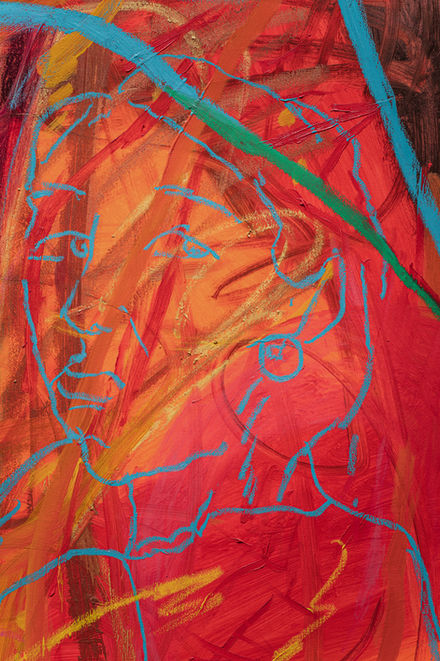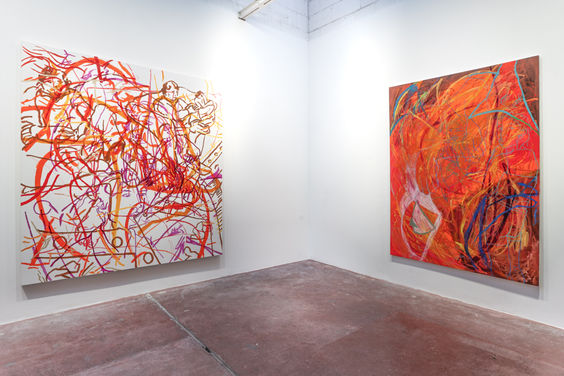
Pentatonic Tale
2022
MAMA
Pentatonic Tale, MAMA, 10 Greatorex Street
26 November - 28th November 2022
Shades of purple, red, blue and green permeate Wang’s paintings, imbuing them with a characteristic dynamism. The artist wants her artworks to be experiential and to evoke in their audience the very sensations she felt when the depicted scene first occurred. Her canvases are thus permeated with sensory references that help convey the emotional, psychological and physical contexts of the moments that had inspired them.
Wang uses colours to summon tastes, smells and sounds. In My beloved sweet peach of Chengdu is like nothing you’ve ever tasted, Wang uses a pastel palette to invoke the sensations associated with the family birthdays that she has attended in China, and especially the creamy cakes adorned with peaches. The smell of the honey-tasting peach specific to Sichuan becomes the smell of celebration, its shape a symbol of longevity. A close echo of a Sartrean passage where the essence of a lemon is extended throughout all of its qualities - its sourness causing the yellow just as much as the yellow being sour - such intertwining of the olfactory and gustatory with the visual allows Wang to create fully immersive narratives. Her creative process is an act of storytelling, where through the stimulation of the senses, each work unlocks visceral recollections of the past.
Wang’s fascination with the infra-ordinary and the endotic is expressed through her artistic focus on gestures and habits that are often overlooked or otherwise missed entirely. Inspired by Francis Picabia’s techniques of layering and the smooth stitching of differing levels of transparency, often seen in the works of Michael Armitage, Wang interlaces colourful spirals with subtle, illustration-like figures - family members, with whom the artist shares a profound connection. Focusing on the minutiae of faces, she captures unique elements of their physical appearance. These elements, Wang later observes, can either be persistent and unchanging or entirely transient, the latter acting as indexical marks that capture the time-contingent pieces of the depicted moments.
Though the abstract elements in Wang’s work emanate a distinct sense of freedom and experimentation, they come from a rigorous method and discipline that the artist acquired during her musical training. Music requires a high degree of order and control but it is also the pinnacle of abstraction. It is then through the duality of music that we might understand the eclectic nature of Wang’s artistic forms, being careful not to categorise her oeuvre as purely abstract. Wang’s playful, spiralling brushstrokes, scattered with semi-transparent figures and objects, transform the canvases into meditative portraits of scenes from the artist’s life. People change as time progresses and unsurprisingly, so does the artist’s painterly style. Each of her works can be seen as a record of a life that is both constant and constantly in flux; a reminder of Wang’s own evolution and growth as well as a tool for maintaining a psychological continuity, both as an artist, but also sister, daughter, granddaughter, and soon, mother.
The title of the show, Pentatonic Tale, derives once more from Wang’s relationship to music and the way that relationship was influenced by the artist’s mixed heritage. Wang admits that she often thinks about her early music training in China - most traditional Chinese music uses a pentatonic scale - as a ‘coda’ to her later and much more extensive experience with Western composers. In musical terminology, a coda is the concluding passage of a musical piece, typically forming an addition to its basic structure. However, rather than being just an extra element at the end, it is also a lingering afterthought, the final taste that we are left with even once the piece is over. Coda is also Italian for tail; homonymous with ‘tale’, the title thus evokes the story of Wang’s life, a portrait of the artist and her multi-cultural background, a metaphor that creates a unity of content and form between the narrative of the show and the works that help tell it.













































